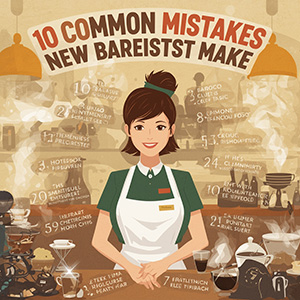10 Common Mistakes New Baristas Make – How to Avoid Them
Becoming a barista is exciting. You get to work with rich aromas, perfect silky milk, and serve beautiful cups of coffee that brighten someone’s day. But like any skill, there’s a learning curve—and it’s easy to slip into habits that can hold you back. Whether you’re aiming to work in a café or simply improve your home barista game, knowing what not to do is just as important as mastering the right techniques.
In this guide, we’ll break down 10 common mistakes new baristas make—and more importantly, how to avoid them. Each tip comes with practical advice, examples, and pro hacks to fast-track your coffee skills.
1. Ignoring the Importance of Fresh Coffee Beans
One of the first mistakes new baristas make is using old or poorly stored coffee beans. Freshness matters—a lot. Coffee starts losing its aroma and flavor shortly after roasting. If you’re brewing with beans that are months old or stored in open containers, you’ll never get the full flavor potential.
Pro Hack:
- Buy coffee that has been roasted within the last 2–3 weeks.
- Store it in an airtight, opaque container away from light and heat.
- Avoid storing beans in the fridge—condensation ruins flavor.
2. Skipping Grinder Calibration
Even with fresh beans, your espresso shot can turn sour or bitter if your grind size isn’t right. Many beginners rely on the grinder’s default settings, which is a big no-no.
The grind determines extraction time—too fine and your coffee will be over-extracted and bitter, too coarse and it will be under-extracted and sour.
Example:
If your espresso is pouring in less than 20 seconds, your grind is too coarse. If it’s taking more than 35 seconds, it’s too fine.
Pro Hack:
- Adjust your grinder daily or whenever you change beans.
- Keep a shot log to track grind settings for different roasts.
3. Not Measuring Properly
Eyeballing your coffee dose or milk volume is an invitation for inconsistency. Great baristas work with precision—using scales, timers, and thermometers to maintain consistency.
Pro Hack:
- Use a digital scale for coffee grounds and yield.
- For milk steaming, use a thermometer until you can judge the temperature by touch.
- Aim for 18–20g of coffee for a standard double-burntshot espresso.
4. Poor Tamping Technique
Tamping is more than just pressing coffee down—it’s about creating a flat, even surface for water to pass through evenly. Uneven tamping leads to channeling, where water finds weak spots and extracts unevenly.
Pro Hack:
- Hold the tamper like a doorknob and press straight down with about 30 pounds of pressure.
- Keep your wrist straight and your elbow at 90 degrees.
- Tap the side of the portafilter gently to settle loose grounds before tamping again.
5. Overheating or Underheating Milk
Many beginners steam milk too hot, resulting in a burnt flavor, or too cool, causing flat foam. Perfect milk has a silky texture with micro-foam—not big bubbles.
Example:
A cappuccino with overheated milk tastes flat and scorched. On the flip side, milk below 55°C feels lukewarm and doesn’t mix well with espresso.
Pro Hack:
- Aim for 60–65°C (140–149°F) for milk drinks.
- Position the steam wand just below the milk surface to create microfoam before submerging it deeper to heat.
6. Neglecting Machine Maintenance
Espresso machines and grinders need regular cleaning. Old coffee oils turn rancid and can ruin every cup you make.
Pro Hack:
- Backflush your machine daily (if it’s commercial).
- Wipe the steam wand immediately after use and purge steam before the next drink.
- Clean the grinder burrs weekly if you use it heavily.
7. Rushing the Extraction
Patience is key in coffee-making. Many new baristas pull shots too quickly, mistakenly believing that speed equals efficiency. But espresso needs proper extraction time to develop flavor.
Example:
An espresso pulled in 10 seconds will taste sour and thin. A proper shot should take 25–30 seconds from the first drip.
Pro Hack:
- Use a timer to monitor extraction.
- If your shots are running too fast or slow, adjust grind size—not tamp pressure.
8. Forgetting the Customer Experience
Coffee isn’t just about taste—it’s also about service. Some beginners get so focused on technique that they neglect friendliness, speed, and presentation.
Pro Hack:
- Always greet the customer warmly.
- Present drinks neatly—wipe the cup rim before serving.
- If you make a mistake, own it and fix it without hesitation.
9. Failing to Experiment
Sticking to one brewing method or recipe limits your growth. A big mistake new baristas make is being afraid to try different roast levels, brew ratios, or milk alternatives.
Pro Hack:
- Experiment with brew ratios like 1:1.5, 1:2, or even 1:2.5 for espresso.
- Try oat or almond milk to learn alternative steaming techniques.
- Test filter brewing methods like pour-over or AeroPress to improve palate training.
10. Not Asking for Feedback
Feedback is one of the fastest ways to improve, yet many avoid it. Whether from a head barista, a coworker, or a customer, constructive criticism can fine-tune your craft.
Pro Hack:
- Ask specific questions like, “Was the milk texture good?” instead of “How was it?”
- Keep a journal of feedback and action steps for improvement.
Final Thoughts
Avoiding these 10 common mistakes new baristas make will dramatically improve your coffee game. Remember, great baristas aren’t born—they’re made through consistent practice, attention to detail, and a willingness to learn.
From storing beans properly to nailing milk texture, every small improvement compounds into better drinks, happier customers, and a stronger career in coffee. Embrace the process, keep refining your skills, and never lose sight of the fact that every cup you make is an opportunity to share something special.

